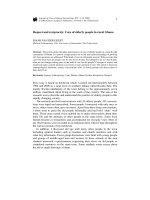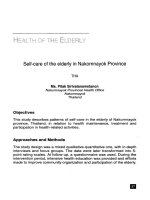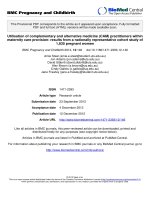Th e Care of Brute Beasts A Social and Cultural Study of Veterinary Medicine in Early Modern England pot
Bạn đang xem bản rút gọn của tài liệu. Xem và tải ngay bản đầy đủ của tài liệu tại đây (2.47 MB, 191 trang )
e Care of Brute Beasts
History of Science and
Medicine Library
VOLUME 14
e Care of Brute Beasts
A Social and Cultural Study of Veterinary
Medicine in Early Modern England
By
Louise Hill Curth
LEIDEN • BOSTON
2010
On the cover: Detail of the cover of L. Mascal, e Government of Cattle (London, 1662).
Courtesy of the Wellcome Library, London.
is book is printed on acid-free paper.
Library of Congress Cataloging-in-Publication Data
Curth, Louise Hill.
e care of brute beasts : a social and cultural study of veterinary medicine in early
modern England / by Louise Hill Curth.
p. (History of science and medicine library, ISSN 1872-0684 ; v. 14)
Includes bibliographical references and index.
ISBN 978-90-04-17995-0 (hardback : alk. paper)
1. Veterinary medicine England History. I. Title. II. Series: History of science and
medicine library, v. 14. 1872–0684 ;
[DNLM: 1. Veterinary Medicine history England. 2. History, 17th Century
England. 3. History, 18th Century England. 4. History, Early Modern 1451–1600
England. SF 657 C979c 2010]
SF657.C87 2010
636.089’0942 dc22
2009040279
ISSN 1872-0684
ISBN 978 90 04 17995 0
Copyright 2010 by Koninklijke Brill NV, Leiden, e Netherlands.
Koninklijke Brill NV incorporates the imprints Brill, Hotei Publishing,
IDC Publishers, Martinus Nijho Publishers and VSP.
All rights reserved. No part of this publication may be reproduced, translated, stored in
a retrieval system, or transmitted in any form or by any means, electronic, mechanical,
photocopying, recording or otherwise, without prior written permission from the
publisher.
Authorization to photocopy items for internal or personal use is granted by Koninklijke
Brill NV provided that the appropriate fees are paid directly to e Copyright Clearance
Center, 222 Rosewood Drive, Suite 910, Danvers, MA 01923, USA.
Fees are subject to change.
To my mother Joyce Ruth Hill and my favourite animals Vladimir and
Brigadoon (past) and Bessie and Pooh-bah (present)
CONTENTS
Acknowledgements ix
List of Illustrations xi
Introduction 1
PART ONE
SETTING THE SCENE
I. Animals in Early Modern Society and Culture 13
II. e Principles behind Health and Illness 32
PART T WO
STRUCTURES OF KNOWLEDGE
III. e Medical Marketplace for Animals 53
IV. e Print Culture and Veterinary Medicine 70
PART THREE
STRUCTURES OF PRACTICE
V. ‘To Keep Out Disease’: Preventative Medicine 99
VI. Remedial Medicine 118
Epilogue: Veterinary Medicine in the Eighteenth Century 142
Bibliography 163
Index 175
ACKNOWLEDGEMENTS
My interest in the history of veterinary medicine is due, in no small
part, to the very important role that several dogs have played and con-
tinue to play in my life. Without doubt, I am in total agreement with
John Caius’ view in Of Englishe Dogges (1576) that ‘there is not any
creature without reason, more loving to his Master, nor more servicea-
ble then is a dog’. at said, I admit to a general weakness for most types
of ‘four footed beastes’ all of whom contribute so much to our lives.
In addition, I would like to publicly thank some of the ‘human crea-
tures’ who have played an important role in the evolution of this book.
ese include Professor Peter Edwards, the uncontested expert on early
modern horses, for his unfailing enthusiasm and support of my work.
It is also a pleasure to express my gratitude to Professor Alan Booth for
his ideas, practical help and encouragement through the many stages
this book has gone through. Many thanks are due to Boris van Gool,
my editor, and his colleagues at Brill. Finally, I owe a very special debt
of gratitude to Rachael Cross and the Wellcome Trust Library, who
have kindly allowed me to reproduce a selection of images from their
outstanding collection of early modern veterinary texts.
All errors of fact or interpretation which remain are, of course, my
own.
LIST OF ILLUSTRATIONS
Chart
Chart 2.1. e humoural theory. 35
Figures
Figure 1.1. Cover of L. Mascal, e Government of Cattle
(London, 1662). 18
Figure 1.2. Frontispiece of J. Blagrave, e Epitomie of the
Whole Art of Husbandry (London, 1675). 21
Figure 4.1. Cover of G. Markham, Markham’s Maister-piece
(London, 1636). 82
Figure 6.1. Illustration from C. Estienne, Maison rustique,
or e countrey farme (London, 1616). 122
Figure 6.2. Illustration from J. de Solleysel, e compleat
horseman (London, 1679). 123
1
R. Porter, ‘Man, Animals and Medicine at the Time of the Founding of the Royal
Veterinary College’ in A.R. Mitchell (ed.), History of the Healing Professions, 3 (London,
1993), p.19.
2
E. Cotchin, e Royal Veterinary College: A Bicentary History (Buckingham, 1990),
p. 13; R. Dunlop and D. Williams, Veterinary History (London, 1996); D. Karasszon,
A Concise History of Veterinary Medicine, trans. E. Farkas (Budapest, 1988); I. Pattison,
e British Veterinary Profession 1791–1948 (London, 1984); L. Pugh, From Farriery to
Veterinary Medicine 1785–1795 (Cambridge, 1962); F.J. Smithcors, Evolution of the
Veterinary Art: A Narrative Account to 1850 (London, 1958); J. Swabe, e Burden of
Beasts: A Historical Sociological Study of Changing Human-Animal Relations and the
Rise of the Veterinary Regime (Amsterdam, 1997) and L. Wilkinson, Animals and
Disease: An Introduction to the History of Comparative Medicine (Cambridge, 1992).
3
R. Dunlop and D. Williams, Veterinary History, p. 266; D. Karasszon, Concise
History, p. 270; and I. Pattison, Veterin ar y, p. 2.
INTRODUCTION
It is a sad fact that historians of human medicine and historians of
veterinary medicine seem to have relatively little contact with each other.
Indeed, in the academic world, it is automatically assumed that a ‘histo-
rian of medicine’ is a person who works on the history of human medi-
cine…One unhappy aspect of this is an appalling dearth of signi cant
writings on the history of British veterinary medicine.
1
is book is about medical beliefs and practices for animals in early
modern England. Although there are numerous texts on the subject of
human health, this is the rst to focus exclusively on animals during
this period. e main reason for this is probably linked to the dichot-
omy of medical historians that Roy Porter referred to over een years
ago. Today, the majority tend to focus on the experience of health and
illness for humans over the centuries. ese historians have been joined
over the past decade by a small, but growing number of academics
interested in veterinary medicine. Unfortunately, their writings tend to
link the beginning of ‘modern’ animal medicine with the foundation of
the London Veterinary College in 1791.
2
As a result, what might be
called the ‘pre-veterinary’ period is either excluded, or fallaciously
described as a time of ‘unscienti c’ treatments administered by igno-
rant, one-dimensional and dangerous quacks.
3
Such stereotypical conclusions about the history of early modern
veterinary medicine seem to be based on two interconnected problems.
2
4
C.W. Schwabe, Veterinary Medicine and Human Health (Baltimore, 1984), p. 2. For
more on attitudes to animals see: K. omas, Man and the Natural World: Changing
Attitudes in England 1500–1800 (London, 1983) and E. Fudge, Perceiving animals:
humans and beasts in early modern Culture (Basingstoke, 2000).
5
A. Wear, ‘Religious Beliefs and Medicine in Early Modern England’ in H. Marland
and M. Pelling (eds.) e Task of Healing: Medicine, Religion and Gender in England
and the Netherlands 1450–1800 (Rotterdam, 1996), p. 145 and M. Pelling, ‘Trade or
Profession? Medical Practice in Early Modern England’ in e Common Lot: Sickness,
Medical Occupations and the Urban Poor in Early Modern England (London, 1998),
p. 232.
6
H. Sigerist, A History of Medicine, I (Oxford, 1951), p. 31.
7
K. Dewhurst, Willis’s Oxford Casebook (Oxford, 1981), p. vii.
e rst suggests that there was a medical void, or absence of a system-
atic method of preventative and remedial medicine. is is a surprising
and even nonsensical idea given the major role that animals played in
early societies. eir sheer economic importance demanded the pres-
ence of an organised medical system to ensure that they would remain
productive members of society. A er all, as Charles Schwabe has aptly
argued, the main reason veterinary medicine was created was to keep
animals healthy so that they could continue to provide bene ts to man-
kind. is is not to negate the many moral and ethical reasons behind
helping sick animals, but it seems likely that, out of necessity, economic
concerns remained at the forefront, demanding that everything possi-
ble be done to protect their health.
4
As this book will show, this involved
the creation of a whole social structure to de ne health and illness, in
addition to providing a range of preventative and remedial treatments
which were discussed in widely available manuals which targeted dif-
ferent types of readers.
A second reason for the stereotypes about animal health care is
related to both historical and modern anthropocentrism. e under-
lying theory rests on the assumption the most important creatures on
earth are human. is would support the view that human health was
of both the greatest interest and worth to study. In the early part of
the twentieth century this was illustrated in the emphasis of ‘medical
discoveries and elite [university educated male] practitioners’.
5
In
1951 Henry Sigerist de ned those who studied medical history as
‘physician[s], trained in the research method of history’.
6
Not surpris-
ingly, the work of such ‘historians’ also displayed a tendency to trans-
pose twentieth century concepts and beliefs onto the past. is
included the negation of earlier ideas and practices which were ‘infe-
rior’ to modern ones.
7
is is a problematic comment which suggests,
3
8
P. M. Teigen, ‘Reading and Writing Veterinary History’, Veterinary Heritage, 24,
no.,1 (May 2001), 3–8
9
R. Porter, ‘Civilisation and Disease: Medical Ideology in the Enlightenment’ in
J. Black and J. Gregory (eds.) Culture, Politics and Society in Britain 1660–1800
(Manchester, 1991), p. 155; J. Swabe, e Burden of Beasts; R. Dunlop and D. William,
Veterinary Medicine; L. Wilkison, Animals and Disease and C.W. Schwabe Vete rinar y
Medicine and Human Health; I. Pattison, e British Veterinary Profession; L. Prince,
e Farrier and His Cra : e History of the Worshipful Company of Farriers (London,
1980); L.P. Pugh, From Farriery to Veterinary and F.J. Smithcors, Evolution of the
Veterinary Art.
10
L.P. Pugh, From Farriery to Veterinary, p. 44; F.J. Smithcors, Evolution of the
Veterinary Art, p. 247 and I. Pattison, e British Veterinary Profession, p. 2.
rstly, that early modern patients and practitioners were naïve and
perhaps even ignorant and secondly, that only ‘scienti c’ medicine is
‘good’ or ‘right’. Such judgmental ideas not only deny the validity or
worth of earlier belief systems of health and illness, but the way in
which people chose to deal with them. Fortunately, most modern his-
torians of human medicine have long since abandoned such ideas in
favour of an exploration of more socio-cultural dimensions.
Veterinary writers, however, o en appear to be stuck in this earlier
form of academic thinking. According to Philip Teigen, the most com-
mon reasons for writing works on veterinary history are either:
1. To celebrate achievements and innovations of important veterinar-
ians or institutions.
2. To explain who, what, why, when, where and how a speci c event
occurred.
3. To advise or recommend a course of action based on lessons learned
form the past.
8
Unfortunately, most are still very judgemental and contain at least
some commonplaces on animals’ healers being ignorant, shallow or
even dangerous before the advent of ‘professional’ veterinary training.
9
e title From Farriery to Veterinary Medicine 1785–1795, for example,
suggests that the foundation of the London Veterinary College in 1791
was a cataclysmic event which meant that it was no longer true that ‘the
most fortunate sick animals … were those le untreated’. According to
Leslie Pugh, this was because the majority of animal practitioners were
‘mainly incredibly ignorant’.
10
Such dramatic language was toned down
in the early 1980’s, although many of the sentiments remain much the
same. Lise Wilkinson, who wrote a number of works on veterinary his-
tory, continued to tell readers that until the 1790’s ‘veterinary medicine
4
11
L. Wilkinson, Rinderpest and Mainstream Infectious Disease Concepts in the
Eighteenth Century, Medical History (April 1984), 28(2), 129–250 and L. Wilkinson,
Animals and disease, p. 10.
12
J. Swabe, e Burden of Beasts, p. 76; R. Porter, ‘Man, Animals and Medicine, 19–30
and R. Dunlop and D. Williams, Veterinary Medicine, p. 273.
13
A. Wear, Knowledge and Practice in English Medicine 1550–1680 (Cambridge,
2000), p. 3.
as such was non-existent both in theory and practice apart from a few
treatises of diseases of the horse’. Despite the wide range of popular
veterinary texts purporting to be written for animal healers, Wilkinson
continued to insist that the majority were ‘for the most part illiterate’.
11
is theme has continued into more recent books on veterinary
medicine, none of which focus speci cally on the early modern period.
Joanna Swabe has commented on how the foundation of the college
aimed to ‘remove the medical treatment and care from these purport-
edly brutal and socially inferior empirics’ in order to ‘place it in those
of trained and scienti cally educated men’. In 1993 Roy Porter pointed
out that the ‘standard story’ about animal health care before this point
was one of ‘ignorant and cruel’ or even ‘barbaric’ practices. Even the
most recent survey of veterinary history, which appeared in 1996,
negates early modern practitioners as being ‘crude empiricists’.
12
Such ideas mirror the thoughts of early human historians, with the
idea that only ‘great doctors’ and discoveries about human health were
worthy of attention. In fact, this book will show that early modern vet-
erinary medicine had a hierarchy of healers and was linked to the same
principles and practices found in contemporary human medicine.
Based on time honoured ancient Greek principles of health and illness,
healers focused on a holistic system that emphasised the importance of
a good health regimen to build a strong body and to keep the humours
in as balanced a state as possible. As later chapters will show, the holis-
tic model of Galenic medicine had reigned supreme for many centu-
ries, continuing into the eighteenth century, forming the core of the
curriculum at the London Veterinary College founded in 1791. is
should not be surprising to modern readers, for as Andrew Wear has
pointed out, the ‘culture of medicine had long roots in time and changed
slowly ….but was part of the lived present’.
13
Although Wear was refer-
ring to human medicine, my research has uncovered a similar continu-
ity of beliefs and practices in animal health care throughout this period.
Such ndings further support the growing interest in comparative
medicine which may well help to ‘modernise’ the general study of
5
14
E.J.L. Soulsby, Royal Society of Medicine News, 15 September 1998.
15
M. Lindemann, Medicine and Society in Early Modern Europe (Cambridge, 1999),
p. 1.
veterinary history, a need which was pointed out by Lord Soulsby, the
rst veterinarian to become President of the Royal Society of Medicine,
argued a decade ago.
14
ere are many reasons why it is important to study veterinary his-
tory on its own, and in conjunction with human health. Both o er
insights into a range of contemporary social and cultural patterns. On
the broadest level this includes the work of a spectrum of men and
women who choose to treat animals. e large number of texts which
focused on health and illness has much to say about the relationship
between the printed word and growing literacy. It also encompasses the
history of education, occupations and the emergence of professions.
e examination of medical beliefs and practices provides glimpses of
the ways in which animals were perceived and valued by the societies
in which they lived. Finally, it can provide a background and context
for understanding how ‘modern’ veterinary medicine developed and
perhaps even some clues as to why.
is book cannot, of course, cover all of these topics. Instead, it aims
to touch upon a number of key areas as a starting point for further
research and discussion. By virtue of being the rst academic text to
focus on early modern veterinary medicine, it also covers a somewhat
amorphous era. ere are many ways to de ne the ‘early modern
period’, although the most frequently used parameters are probably
from roughly 1500–1800. Since this book is, hopefully, going to be a
catalyst for further studies on veterinary history, I have decided to
cover the entire period. is decision has resulted in an inability to
provide as in-depth analysis of the various topics as I would have liked.
at said, it has allowed me to do what Mary Lindemann has referred
to as the ‘mainstreaming’ of medical history. According to this de ni-
tion, the historian ‘li s it out of the con ning limits of a disciplinary
channel and re oats it in broader historical currents’.
15
In the case of
this book, this has allowed me to begin and end at points that hold a
great deal of signi cance to the study of veterinary history. e starting
date is linked to the infancy of mechanical printing, the printed word
and the subsequent boom in medically orientated texts. ese early
years were followed by a continuing growth in the number of books
addressing both human and animal health throughout the sixteenth
6
16
E. Fudge, Perceiving Animals, p. 4.
and seventeenth centuries, which form the major part of my work. e
book closes by looking at the eighteenth century, which illustrates a
marked continuity of beliefs and practices despite the claim that ‘mod-
ern’ veterinary medicine began with the advent of the London College
in 1791.
e Chapters
is book has been divided into three main sections and an epilogue. In
order to provide a context for later discussions, the rst two chapters
will ‘set the scene’ through an examination of the contemporary beliefs
about animals and ideas about health and illness. e second section
will focus on the medical options that were available for animals during
this period. Contrary to historical commonplaces, this included a huge
range of choices. ese two chapters will look rst at the range of ‘pro-
fessional’ and lay-healers in the ‘medical-marketplace’ before moving
on to the huge variety of readily available ‘popular’ veterinary literature.
e third section will continue with an examination of the structures of
practice and knowledge, divided into the components of preventative
and remedial medicine. Finally, the book will conclude with an epi-
logue which will examine the question of whether the eighteenth cen-
tury actually experienced the birth of ‘modern’ veterinary medicine.
It is generally agreed that the ways in which animals were viewed
was based on ‘theological, humanist, scienti c and legal early modern
writings [which] represent animals as being the antithesis of humans’.
16
Although Christian theology did lie at the heart of early modern senti-
ments, the rst chapter will suggest that it was economic and commer-
cial, rather than religious or ethical, sentiments that provided the most
support for anthropocentrism. ere were on-going debates on issues
such as whether animals had souls, could feel emotions and pain or be
used for scienti c experimentation. However, I believe that in the
mainly agrarian society of the time economic considerations took prec-
edence. A er all, animals were a vital source of labour, food and other
by-products which demanded that humans did all they could to pro-
tect the health of their animals and treat them when they were ill.
7
17
K. White, An Introduction to the Sociology of Health and Illness (London, 2007),
p. 5.
18
L. Hill Curth, ‘History of Health and Illness’ in J. Naidoo and J. Wills (ed) Health
Studies: an introduction, 2nd edition (London, 2008), 47–72.
19
L. Hill Curth, ‘ e Care of the Brute Beast: Animals and the Seventeenth-Century
Medical Marketplace’, Social History of Medicine, 15 (2002), pp. 375–392.
20
See, for example, L. Kassell, Medicine & Magic in Elizabethan London (Oxford,
2005), p. 4; M. Pelling, Con icts in Early Modern London: Patronage, Physicians
Chapter 2 will move on to an explanation of the ways in which health
and illness were understood and treated in early modern England.
Ideas about what constitutes a state of health or illness are social con-
structs, which can di er dramatically between groups of people, par-
ticularly over time. e ways in which we view these concepts, organize
and train medical professionals and treat disease are both produced in
and re ect the structural features of a particular society.
17
In modern
Western Europe the major emphasis is biomedical, based on the idea of
pathogens attacking the body which results in disease. During the early
modern period the focus was a holistic one, centering on building a
strong body and preserving a state of health. Humans were encouraged
to follow what we would now call a ‘healthy lifestyle’ and to provide
something similar for their animals based on the ancient principles
developed by Hippocrates and Galen.
18
e third chapter will introduce the concept of the ‘medical market-
place’ for animals. Although this is a term that has previously only been
applied to humans, my research suggests that practitioners and options
for animals should be viewed as an extension of the ‘human’ medical
marketplace.
19
Far from being made up of illiterate, barbaric practi-
tioners, this marketplace included highly trained members of the
Company of Farriers. It will also discuss the many other types of ani-
mal healers in the marketplace, many of whom appeared to have at
least a rudimentary literacy, as well as the large numbers of men and
women who are probably best placed under the label of ‘lay’ healers.
Chapter 4 will focus on the variety of written information available
to all types of healers, beginning with the advent of the printing press
in the late 15th century. is is a particularly fruitful source of material
for medical historians, but particularly for those interested in animal
healthcare. Most modern medical historians study socio-cultural
aspects such as ‘the experience of illness’ by using a range of manuscript
and printed materials.
20
Unfortunately, while the health of animals is
8
and Irregular Practitioners 1550–1640 (Oxford, 2003); A. Wear, ‘Medical Practice in
Late Seventeenth and Early Eighteenth Century England: Continuity and Union’ in
R. French and A. Wear (eds) e Medical Revolution of the Seventeenth Century
(Cambridge, 1989), 294–320; H. Cook, e Decline of the Old Medical Regime in Stuart
London (London, 1986), pp. 28–67; and C. Webster, e Great Instauration: Science,
Medicine and Reform 1626–1700 (Oxford, 1979).
21
See, for example, M. Hunter and A. Gregory, An Astrological Diary of the
Seventeenth Century (Oxford, 1988); W.H. Sherman, John Dee: e politics of reading
and writing in the English Renaissance (Amherst, 1995); P. Slack, ‘Mirrors of Health and
Treasures of Poor Men: e Uses of the Vernacular Medical Literature of Tudor
England’ in C. Webster (ed.) Health, Medicine and Mortality in the Sixteenth Century
(Cambridge, 1979), pp. 237–74; W.H. Sherman, ‘What Did Renaissance Readers Write
in eir Books?’ in J. Andersen and E. Sauer (eds.) Books and Readers in Early Modern
England: Material Studies (Philadelphia, 2002), pp. 126–130.
22
F. Smith, e Early History of Veterinary Literature and its British Development:
Vol. I (London, 1919 and 1976), p. 123.
o en referred to in correspondence, there is a distinct paucity of records
kept by healers and, of course, a total lack of ‘ rst-hand’ accounts. ere
are, however, other ways to examine the social history of veterinary his-
tory, with the least utilized source being popular medical books.
ese included a wide range of publications aimed at many di er -
ent segments of the public, from the highly educated to the barely
literate. Although modern medical historians employ a variety of
source materials, until fairly recently, the use of popular medical litera-
ture has been relatively neglected. ere are now a number of studies
that look at a range of issues from readership to what texts can tell us
about contemporary society.
21
e study of veterinary literature, how-
ever, has consisted mainly of the magisterial work of the early twentieth
century antiquarian Sir Frederick Smith. Written over a number of
years, this four volume set follows veterinary writers from the earliest
known manuscripts through the nineteenth century. It was a phenom-
enal feat for Smith to locate and read so many works. Unfortunately, his
personal bias against ‘pre-modern’ veterinary beliefs and practices is
very clear in his writing. In common with both previous and later writ-
ers, Smith uses the founding of the veterinary college as a dividing
point from earlier texts.
22
As this chapter will show, there is ample sur-
viving proof of a systematic, holistic model of health for animals in
con temporary texts written by a range of ‘professional’ and lay-healers
which provide insights into contemporary medical beliefs and prac-
tices. In addition, they o er a range of indirect and direct evidence
about the demand for such information. As Ian Maclean has aptly
noted ‘the decision to reprint an author was made by directly commercial
9
23
I. Maclean, Logic, Signs and Nature in the Renaissance (Cambridge, 2002), p. 53.
24
P. Physiologus, e Good housewife made a Doctor (London, n.d.), sig. A2v and
L. Coelson, An almanack (London, 1680), sig. C6v.
considerations’.
23
e vast number of editions of works by authors such
as Gervase Markham clearly illustrates the great and on-going popu-
larity of the material. Furthermore, the material found in contempo-
rary popular texts contradicts stereotypes that veterinary medicine
consisted solely of harsh, dangerous treatments administered by igno-
rant, one-dimensional quacks. ey illustrate the continuing predomi-
nance of traditional, holistic Galenic beliefs and the practices linked to
it while challenging the claims of major changes linked that to the
foundation of the rst English veterinary college in 1791.
A er the discussion of medical options and information, the third
section will move on to structures of practice and knowledge. Chapter 5
will begin by explaining the principles that lay behind preventative
medicine. Unlike modern medicine which focuses on treating illness,
the contemporary emphasis was on not getting sick in the rst place.
As one writer reminded readers, ‘one of the most important Businesses
of this Life [was] to preserve our selves in Health’. Humans were also
expected to provide similar care to their animals by using ‘means to
prevent diseases before they come upon them’.
24
e recommended
way to do this was to have a healthy daily regime based on the Galenic
non-naturals of air, motion and rest, sleep and waking, diet, evacuation
and retention and the passions. However, although the way in which
these factors could be manipulated in terms of human health has been
widely addressed, there are no comparable modern discussions of their
relationship with animals. e most general advice on keeping animals
healthy revolved around not over-working them, providing a warm,
dry place to sleep and appropriate foodstu s for the season. However,
a great deal of in-depth information was available in a range of printed
literature on diet, as well as on periodical, preventative purging to
ensure an even humoural balance.
It seems highly unlikely that people in the early modern period
believed that attempts to maintain a state of good health could always
keep illness at bay, anymore than we do today. Chapter 6 will discuss
the types of remedial medicine that were available for animals when
e orts eventually failed, and disease struck. Most treatments aimed to
purge the system of super uous or unwanted humours through the
various ori ces of the body. Despite the modern misconception that
10
phlebotomy was the most commonly used procedure; texts suggest
that various concoctions of organic materials were most likely to be
tried rst. Although modern works tend to suggest that these would
mirror human remedies, this was not always the case. ‘Shared’ diseases
were o en treated with di erent preparations with cheaper or more
easily accessible ingredients being used for animals.
e nal chapter will examine the state of veterinary medicine in the
eighteenth century alongside the common claim that it marked the
beginning of modern, ‘scienti c’ practices. Although there are various
explanations for this, they all culminate in the founding of the London
Veterinary College in 1791. In terms of simple common sense, it seems
highly unlikely that the beginning of any new institution could result in
such a mercurial change in medical beliefs and practices. As this book
will show, the long established system of veterinary care in England
continued through the eighteenth century and was, in fact, the basis of
teaching in the new college. is raises the question of why, if such
methods were indeed ‘ine ective’ they were still being used on animals
who were only of value when healthy? Furthermore, what kind of peo-
ple would have allowed healers who were ignorant and possibly even
dangerous to in ict even more pain and su ering on their charges?
I would argue that the period before the founding of the rst London
Veterinary College more than deserves serious academic study, which
will bene t both our understanding of both animal and human health
illness in the past, as well as today.
PART ONE
SETTING THE SCENE









